Learn More About Eye Conditions
The eye is a truly incredible organ that allows us to navigate through our daily routines. Without proper care and attention, the eye’s functionality can quickly change. Though myopia and hyperopia are extremely common and not preventable, we offer a variety of vision treatment options. To better understand the eye, the following page features information about several common eye disorders, including myopia, hyperopia, presbyopia, astigmatism, and cataracts.
If you wear glasses and/or contact lenses and are considering laser vision correction or intraocular lens implants, please schedule a refractive surgery consultation at one of our locations in Austin or Cedar Park. During your vision correction consultation, our refractive surgeons will identify any vision and eye health problems you may have and determine the most appropriate treatment for your visual needs.
- How the Eye Works
- Myopia (Nearsightedness)
- Hyperopia (Farsightedness)
- Astigmatism
- Presbyopia
- Cataracts
- Glaucoma
- Retina
How the Eye Works
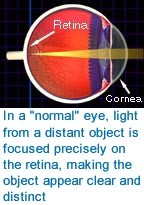 In order for the eye to see clear images, the cornea (the clear portion of the front of the eye) and the lens must bend or curve light rays so that the rays are able to properly focus on the retina (the inner lining of the eye). The retina is responsible for changing these light rays into signals that are then sent to the brain and accepted as an image.
In order for the eye to see clear images, the cornea (the clear portion of the front of the eye) and the lens must bend or curve light rays so that the rays are able to properly focus on the retina (the inner lining of the eye). The retina is responsible for changing these light rays into signals that are then sent to the brain and accepted as an image.
A person with normal eyesight is able to see clear images because the cornea and lens are focusing images on the retina without error. A person with refractive error sees blurry or hazy images because the cornea and lens are unable to focus light rays on the retina. This can be attributed to an improperly shaped eye (myopia, hyperopia, and astigmatism); a loss of lens accommodation (presbyopia); or a clouding of the lens of the eye (cataracts).
Fortunately, there are a variety of new and exciting treatments for myopia, hyperopia, presbyopia, and astigmatism. These treatments are designed to either reshape the eye to correct refractive error, or replace the natural lens of the eye to improve accommodation while also correcting refractive error. Contact Texan Eye in Austin to learn more about our vision correction options.
Myopia (Nearsightedness)
 Myopia is the second most common type of refractive error. It affects approximately one-third of the population. Myopia results when the eye is too long or the cornea is too steeply curved relative to its distance to the retina. Patients with myopia are able to see near objects clearly but have difficulty seeing objects at a distance. Distant objects appear blurry because light from a far away object focuses in front of the retina rather than directly on the retina. Myopia can be easily diagnosed with a simple eye exam at one of our Austin area laser vision correction centers.
Myopia is the second most common type of refractive error. It affects approximately one-third of the population. Myopia results when the eye is too long or the cornea is too steeply curved relative to its distance to the retina. Patients with myopia are able to see near objects clearly but have difficulty seeing objects at a distance. Distant objects appear blurry because light from a far away object focuses in front of the retina rather than directly on the retina. Myopia can be easily diagnosed with a simple eye exam at one of our Austin area laser vision correction centers.
How is Myopia Treated?
Myopia can be treated with LASIK, ASA, lens implants, or general ophthalmology services, including glasses and contact lenses. At our Austin practice, laser vision correction with LASIK or ASA is the most popular choice for patients with myopia who seek to eliminate or reduce their dependence on glasses or contact lenses. During laser vision correction with LASIK or ASA, the refractive surgeon uses an excimer laser to “flatten” the cornea, thereby reducing curvature. This allows light from distant objects to focus directly on the retina, sending clear and precise images to the brain.
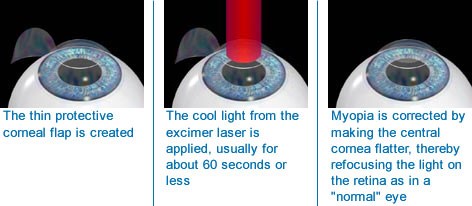
ASA (Advanced Surface Ablation) is a technologically enhanced version of PRK (Photorefractive Keratectomy). ASA is another treatment offered at our Austin laser vision correction centers for patients with myopia. Visit our FAQs page to find out which type of refractive surgery is appropriate for your needs.
Hyperopia (Farsightedness)
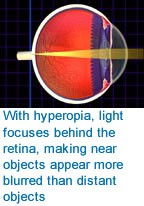 Hyperopia is the third most common refractive error. It affects approximately one-fourth of the population. It occurs when the eye is too short or the cornea is too flat. Hyperopia causes difficulty seeing objects close up, and in severe cases, can also make it difficult to see objects clearly at a distance. Vision from a short distance appears blurry for hyperopic patients because light focuses behind the retina rather than directly on the retina. The eye care specialists at our Austin vision correction centers can diagnose hyperopia with a comprehensive eye exam.
Hyperopia is the third most common refractive error. It affects approximately one-fourth of the population. It occurs when the eye is too short or the cornea is too flat. Hyperopia causes difficulty seeing objects close up, and in severe cases, can also make it difficult to see objects clearly at a distance. Vision from a short distance appears blurry for hyperopic patients because light focuses behind the retina rather than directly on the retina. The eye care specialists at our Austin vision correction centers can diagnose hyperopia with a comprehensive eye exam.
How is Hyperopia Treated?
To correct hyperopia, it is necessary to alter the way light focuses on the retina. This can be achieved with LASIK, ASA, lens implants, glasses or contact lenses. At our Austin practice, laser vision correction with LASIK or ASA is the procedure of choice for patients with hyperopia. During laser vision correction surgery with LASIK or ASA, the cornea is reshaped with an excimer laser, essentially “steepened” to allow light to focus directly on the retina rather than behind it. This improves the eye’s ability to focus on objects close to they eye such as a computer screen, a magazine or a book.
Visit our LASIK and ASA page for an in-depth look at how laser vision correction can be applied to treat hyperopia.
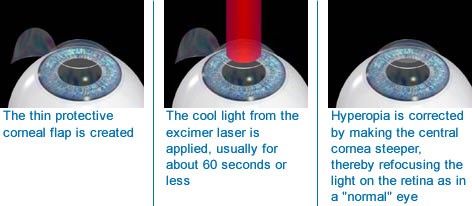
Astigmatism
 Astigmatism is the most common type of refractive error. It is linked to an irregularly shaped cornea or lens. Patients with astigmatism have blurred vision at all distances. While a normal eye is shaped like a sphere, the eye of someone with astigmatism is shaped like a football. This causes light rays to focus more in one direction than the other, meaning only partial focus can be achieved at any time.
Astigmatism is the most common type of refractive error. It is linked to an irregularly shaped cornea or lens. Patients with astigmatism have blurred vision at all distances. While a normal eye is shaped like a sphere, the eye of someone with astigmatism is shaped like a football. This causes light rays to focus more in one direction than the other, meaning only partial focus can be achieved at any time.
Astigmatism can occur alone or alongside myopia or hyperopia and presbyopia. It is important to schedule an eye exam at one of our Austin or Cedar Park centers for proper diagnosis and treatment of astigmatism.
How is Astigmatism Treated?
Astigmatism can be treated with LASIK, ASA, AcrySOF® Toric lens implants, glasses, or contact lenses. At our eye centers in Austin, we offer laser vision correction for the simultaneous correction of astigmatism, hyperopia, and myopia. During the surgery, the cornea is made into a more spherical shape with an excimer laser.
The eye surgeons with Texan Eye in Austin use advanced laser vision correction technology to treat patients with astigmatism. With the newest generation of VISX®, and NIDEK excimer lasers, our surgeons are able to correct astigmatism, hyperopia, and myopia during a single procedure. If you are considering refractive surgery, contact Texan Eye in Austin today to schedule a Refractive Surgery Consultation with one of our premier eye surgeons.
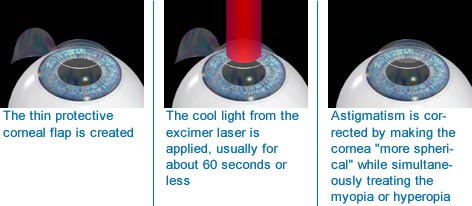
Presbyopia
Presbyopia is a common condition that generally affects men and women over the age of 40. It results in blurry vision when trying to see objects up close. If you notice that you are having a difficult time focusing while reading or engaging in other activities that rely on your up close vision, you most likely have presbyopia. The change in vision associated with presbyopia is due to the fact that over time, the lens of the eye loses its ability to “accommodate,” or change focus. Presbyopia tends to be progressive but it is not a disease. It is simply a natural part of the aging process.
Presbyopia is sometimes confused with hyperopia (farsightedness), but the two conditions are completely distinct from one another. Patients with hyperopia share much of the same difficulty with near vision, but this is due to an irregularly shaped eye, while change of vision from presbyopia is caused by an inflexible lens, or the inability to accommodate.
If you are unsure whether your loss of near vision is being caused by presbyopia or hyperopia, contact Texan Eye to schedule a comprehensive eye exam.
How is Presbyopia Treated?
Presbyopia can be treated with glasses, contact lenses or surgical correction. Surgical correction of presbyopia can be achieved with monovision LASIK, ASA, or intraocular lens implants. A consultation with one of our premier surgeons will help you decide on the most appropriate treatment for your visual needs.
Monovision refers to the process of correcting one eye for distance vision and one eye for near vision. This allows patients to see up close with the “non-dominant” eye and at a distance with the other “dominant” eye, producing what is known as “monocular vision”. Monovision can be achieved with LASIK, ASA, lens implants, or contact lenses.
Lens implants are designed to replace the eye’s natural lens that is clouded by cataracts. Moreover, lens implants have the added benefit of simultaneously correcting myopia, hyperopia, and astigmatism in patients with presbyopia. These technologically advanced designs have different mechanisms of action. The Crystalens® lens implant is flexible and can change shape, or “accomodate” to allow the eye to change focus. The lens implants ReSTOR® and Tecnis® are multifocal and remain stationary. The AcrySOF® Toric lens implant corrects astigmatism. These lens implants produce a much higher quality of vision for patients.
Contact Texan Eye to find out more about presbyopia vision correction.
Cataracts
A cataract is a clouding of the natural lens inside the eye that prevents light from focusing clearly on the retina, causing blurry vision. Cataracts are generally thought to be a natural part of the aging process, but they can also be linked to certain medical conditions like diabetes or trauma to the eye. Cataract symptoms become progressively worse over time. If cataracts are left untreated, they can cause significant vision loss.
How Are Cataracts Treated?
The best treatment for cataracts is lens replacement with intraocular lens implants. Over the last decade, cataract surgery has evolved, and treatment has become safer and more effective than ever before. Traditional cataract surgery enhances vision at only one point of focus, typically at a distance. Full Focus® Cataract Surgery with Texan Eye allows vision to be corrected for distance, intermediate, and near ranges. By using high performance accommodating intraocular lenses such as the Crystalens®, and the Tecnis® and ReSTOR® multifocal lenses, the specialists at Texan Eye are able to offer improved visual performance, with results exceeding those from traditional cataract surgery.
At Texan Eye, our doctors were instrumental in developing advanced accommodating intraocular lenses. Our practice performed the FDA clinical trial that then lead to the approval of intraocular lens technology. Our internationally recognized doctors have trained several hundred doctors from around the world in such advanced techniques. Therefore, the choice is clear: eye doctors in Austin choose Texan Eye for their own surgical eye care needs.
For more information on Cataracts, please visit FAQs/Cataracts
Contact Texan Eye to find out more about the eye conditions treated at our Austin and Cedar Park centers.
Glaucoma
Glaucoma refers to a group of eye diseases with the common feature of optic nerve damage. Though glaucoma is usually associated with increased eye pressure, it can develop with normal eye pressure as well. In general, increased intraocular pressure causes optic nerve damage which leads to vision loss; therefore, glaucoma is the second leading cause of blindness. In the early stages of untreated glaucoma, side or peripheral vision is affected and if glaucoma is allowed to progress, it is possible for the entire optic nerve to be destroyed, leading to significant vision loss or irreversible blindness.
Approximately half the cases of glaucoma in the United States go undetected because it often occurs without pain or warning. Therefore, a comprehensive eye exam is recommended on a yearly basis for the early detection and treatment of glaucoma.
How is Glaucoma Treated?
Timely detection is the key to effective treatment of glaucoma. To diagnose and manage glaucoma, we perform visual field testing, measure intraocular pressure and corneal thickness, and assess, photograph and scan the optic nerve using the best technologies available. In general, treatment for glaucoma consists of prescription eye drops, laser therapy and/or surgery with the aim of lowering intraocular pressure and preventing vision loss. As part of successful glaucoma management, we recommend that our patients with glaucoma visit us for periodic checkups as prescribed.
At Texan Eye centers in Austin and Cedar Park we offer comprehensive screenings for the detection of glaucoma. Texan Eye has the most advanced and comprehensive Glaucoma Service in central Texas, with two sub-specialty trained glaucoma surgeons and eight glaucoma trained optometrists. We employ the latest in technology to assist our doctors in evaluating your eyes. Additionally, you have access to novel surgical techniques and advances with Texan Eye, as the doctors participate in ground breaking surgical device studies.
For more information on Glaucoma, please visit FAQs/Glaucoma
Retina
The retina is the thin layer of tissue lining the inner eye that functions like the film of a camera, translating visual information into an image that is sent to the brain. The retina contains an area specialized for fine reading and distance vision called the macula. Because the components of the retina are often subject to a number of diseases and disorders, including macular degeneration, diabetic retinopathy, macular holes, retinal detachment, and more, it is important to have a dilated eye exam on a yearly basis. While other tissues in the eye can be replaced when damaged (including the lens of the eye), retinal tissue must be preserved and repaired. To learn more about treatments for diseases and disorders of the retina, please contact a Texan Eye center near you.
For more information on Age-Related Macular Degeneration, Diabetic Retinopathy, Flashes and Floaters please visit FAQs.
